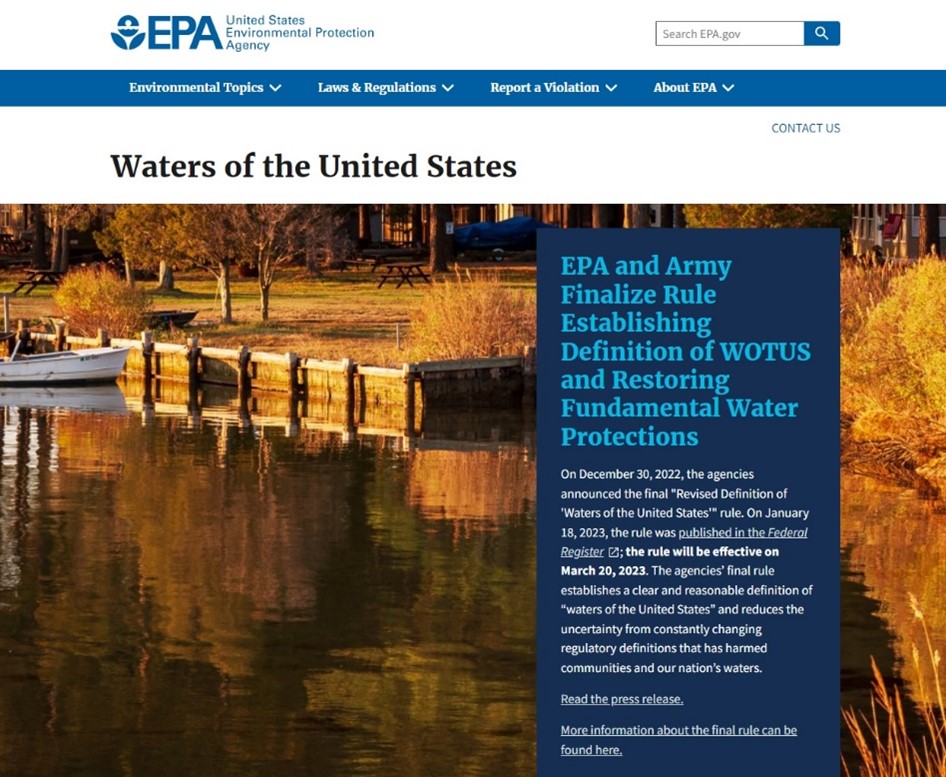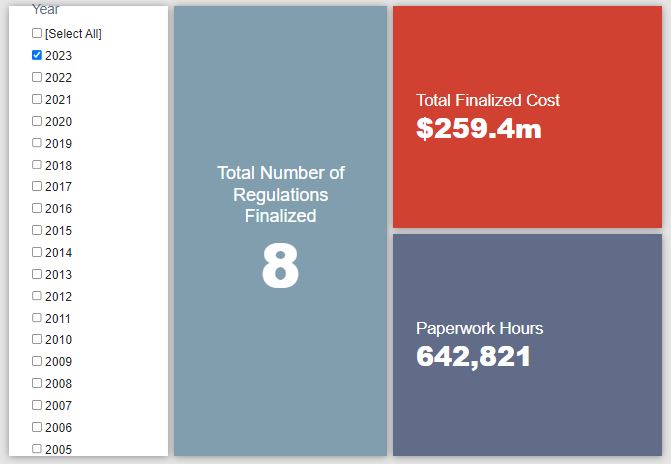Week in Regulation
January 23, 2023
Non-compete Rule Highlights Otherwise Modest Week
Last week saw some fits and starts in the regulatory world, but largely underwhelmed compared to others in recent months. There were 10 rulemakings with some measurable economic impact. Most of these, however, were not particularly significant. A proposed rule from the Federal Trade Commission (FTC) regarding “non-competes” provided the week’s main event. Across all rulemakings, agencies published $1.6 billion in total costs and added 1.6 million annual paperwork burden hours.
REGULATORY TOPLINES
- Proposed Rules: 31
- Final Rules: 61
- 2023 Total Pages: 3,904
- 2023 Final Rule Costs: $259.4 million
- 2023 Proposed Rule Costs: $14.7 billion
NOTABLE REGULATORY ACTIONS
The most consequential rulemaking of the week was the FTC proposed rule titled “Non-Compete Clause Rule.” The proposal would deem most “non-compete clauses” in employment contracts “to be unlawful” under the agency’s authority, effectively banning the practice. A more comprehensive analysis of the rulemaking’s potential implications can be found here. FTC expects the primary compliance burdens for affected firms to be: 1) updating their contractual language and protocol and 2) actively demonstrating compliance to the agency. In its preliminary estimate, FTC estimates these costs to add up roughly $1.3 billion in a given year. Coming on the heels of last year’s proposed rule on car dealerships, this represents only the second time that FTC has waded into the billion-dollar rulemaking realm.
TRACKING THE ADMINISTRATIONS
As we have already seen from executive orders and memos, the Biden Administration will surely provide plenty of contrasts with the Trump Administration on the regulatory front. And while there is a general expectation that the current administration will seek to broadly restore Obama-esque regulatory actions, there will also be areas where it charts its own course. Since the AAF RegRodeo data extend back to 2005, it is possible to provide weekly updates on how the top-level trends of President Biden’s regulatory record track with those of his two most recent predecessors. The following table provides the cumulative totals of final rules containing some quantified economic impact from each administration through this point in their respective terms.
![]()
The Biden Administration saw some modest movement in its final rule totals due primarily to a Department of Agriculture (USDA) rule regarding “National Organic Program (NOP); Strengthening Organic Enforcement.” As the title suggests, the rule seeks “to strengthen oversight and enforcement of the production, handling, and sale of organic agricultural products.” USDA estimates that the total compliance costs from the rule’s new requirements add up to roughly $216 million.
The only other notable action across the other two administrations came from the Obama Administration. While the Trump Administration saw a minimal dip in costs and paperwork from a single rule, the Obama Administration cost total jumped by roughly $500 million. The main driver of this increase was a Department of Transportation vehicle safety rule focused on “Ejection Mitigation.”
Last Friday marked the two-year anniversary of President Biden’s inauguration. Stay tuned later this week for an AAF analysis examining some deeper trends in each of these three administrations as they crossed the midpoint of their respective terms.
THIS WEEK’S REGULATORY PICTURE
This week, an update to the ongoing saga regarding “Waters of the United States,” or WOTUS.

Screenshot via EPA.gov/WOTUS
On January 18, the Environmental Protection Agency and the U.S. Army Corps of Engineers (the agencies) published the latest final rule defining WOTUS, or those waters where the federal government has authority. The definition applies to federal permitting programs and determines where the federal government can prohibit – or require permits for – certain discharges or activities, such as land development. As such, it is a highly consequential definition.
The latest rule essentially restores the pre-2015 definition of WOTUS – but modifies it to incorporate the prevailing opinion in a 2006 Supreme Court case known as Rapanos. That opinion established that WOTUS covers any water feature with a “significant nexus” to a navigable water. The term significant nexus was never inserted in the regulatory code, however.
In 2015, the Obama Administration issued a rule to define WOTUS that incorporated the Rapanos opinion but was widely viewed as being exceptionally broad in coverage. A legal challenge kept the rule from having full effect nationwide, and the Trump Administration developed a narrower definition in 2020. In 2021, a federal court vacated the Trump Administration’s rule, allowing the Biden Administration to issue the latest rule. More specifics on the history of the WOTUS rule can be found here.
For all its consequence, the latest rule will impose no measurable economic costs, according to the agencies. In their view, the rule is comparable to what is the current enforcement practice, and therefore is not affecting the costs involved. Eagle-eyed devotees of AAF’s RegRodeo database will note that when the rule was proposed, AAF attributed estimated costs of $3.9 billion with the action compared to the Trump Administration rule it was replacing. That value was one of two included in the proposed rule by the agencies, which acknowledged “that further developments in litigation over the rule could bring the (Trump era) rule back into effect.” Now that this rule is finalized, the Trump rule will not be coming back – making the more appropriate estimate of costs the baseline that assumes the new rule is generally the same as current practice.
The WOTUS saga has not concluded yet. In October, the U.S. Supreme Court again took up a case related to the definition that could imperil the current practice (and thus the new Biden rule). A decision on that case will happen in the first half of this year. If that were not enough uncertainty, the agencies are also pressing forward with further revisions to the definition that should be proposed by the end of 2023 (also potentially addressing the Supreme Court’s upcoming decision), according to the latest Unified Agenda.
Expect the WOTUS mess to continue.
TOTAL BURDENS
Since January 1, the federal government has published $15 billion in total net costs (with $259.4 million in new costs from finalized rules) and 4.8 million hours of net annual paperwork burden increases (with 642,821 hours in increases from final rules).












